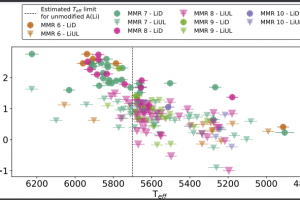Stellar lithium abundances may not be representative of the interstellar medium composition. The study: “The Gaia-ESO Survey: Probing the lithium abundances in old metal-rich dwarf stars in the solar vicinity” of M. L. L. Dantas (Nicolaus Copernicus Astronomical Center) appeared on A&A

The study of chemical abundances in the interstellar medium and stars in our Galaxy is of utmost importance, as it provides insights into the chemical enrichment of the galactic interstellar medium by massive stars and the evolution of different components of the Milky Way. Lithium is frequently the subject of spectroscopic surveys and studies aimed at determining its abundance in stars and establishing its relationship with stellar properties.
For three decades, astronomers believed that determining the upper envelope of lithium abundances in a stellar population was representative of the abundances in the local interstellar medium. The term “upper envelope” refers to the region defined by stars with the highest lithium abundances in diagrams that plot abundances against stellar effective temperatures. However, recent observations have revealed an anomalous decline in the upper envelope of lithium abundance for stars with high metallicity (which indicates the abundance of heavy elements relative to hydrogen). Some studies have suggested that this decline may be attributed to the “contamination” of the observed stellar samples by old stars that migrated from the inner regions of the Galaxy to the Solar neighborhood.
The spectroscopic survey known as the Gaia-ESO Survey (GES), which conducted spectroscopic observations for over 100000 stars using the FLAMES spectrograph mounted on the Very Large Telescope of the European Southern Observatory, provides a unique opportunity to determine chemical abundances across a large and diverse sample of stars. The team led by astronomer M. L. L. Dantas, from the Nicolaus Copernicus Astronomical Center in Warsaw, analyzed GES data for approximately 1400 high-metallicity stars exhibiting chemical and dynamical characteristics indicating radial migration from the inner regions of the Galaxy to the vicinity of the Sun. The analysis unveiled that these stars are responsible for the decline of the upper limit of lithium abundances, supporting the scenario suggesting that the chemical abundances of the interstellar medium cannot be inferred solely from stellar measurements without properly accounting for stellar metallicity and history, including birthplace and dynamics. The study is described in the letter titled “The Gaia-ESO Survey: Probing the lithium abundances in old metal-rich dwarf stars in the solar vicinity” recently published in the journal Astronomy & Astrophysics. Among the co-authors is the astronomer L. Prisinzano from INAF – Astronomical Observatory of Palermo.
The figure (click here to view the complete image) illustrates the lithium abundances (A(Li)) as a function of effective temperature (Teff) for all the high-metallicity stars in the analyzed sample. Stars with detected lithium are represented by circles, while those with available upper limits are indicated by inverted triangles. The vertical line denotes an effective temperature of 5700K.
Mario Giuseppe Guarcello ( follow mariospiegacose) ( mariospiegacose) ( follow mariospiegacose)
Follow the Astronomical Observatory of Palermo on Facebok and on Instagram
Subscribe the Youtube channel of the Astronomical Observatory of Palermo
